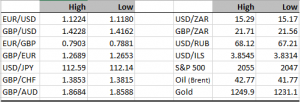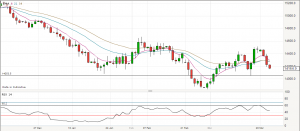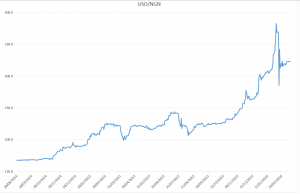A few days ago, I voiced concern about the dynamics of the market potentially making it difficult for the dollar to continue rallying in the short term. It seems that no sooner had I said that the market turned! This is the way of markets, they tests your convictions to the maximum, forcing you to doubt your view, and then it moves, and probably in a way that minimises your profit making potential. Still there is nothing definitive about the current move, we would expect to see key levels taken out before the short term trend can be confirmed.
Here’s the level in cable (GBP/USD). We need to see a break to the downside of 1.4053:
And 1.1058 for EUR/USD:
Yesterday, UK inflation was published, holding steady at +0.3% year on year to February despite forecasts of a modest increase. As some economists observed, inflation is not going anywhere fast in the UK. The markets have now pushed the timing of rate rise expectations back into 2019! So it was no surprise at all that sterling reacted negatively to the news, it fell substantially against a basket of currencies and indeed, EUR/GBP is now testing year to date highs and could easily surpass those levels to make new 12 month highs. As we’ve pointed out many times there is a case to be made for a considerably weaker pound in the coming months, Brexit or no. On the plus side, weaker inflation should give consumers more spending power, but as some economists have also pointed out, this seems to be giving employers the excuse not to raise wages.
Economic realities appear to be catching up with the Central Bank of Nigeria. The weakening of the naira in such an import dependent economy has undoubtedly stoked inflationary pressures, which was confirmed by the higher than expected inflation rate for February published about a week ago. At 11.4% it was the highest level for the measure in about 4 years. With the economy now growing at the slowest rate in well over a decade, it would have been too much of a risk to social stability for the central bank to ignore the difficulties facing the ordinary Nigerian consumer, with poor employment prospects and their disposable income getting eroded by higher inflation. This is probably an attempt of some sort to bolster the level of the naira, or at least defend the official rate, but with demand for dollars vastly outstripping supply in an environment where the central bank is trying to keep hold of reserves, it is unlikely to do much to safeguard the level of the naira in the only market that counts… the parallel market. That said, we have seen some stability come into the parallel market in recent weeks, with USD/NGN, staying in a 320 – 330 range (chart below).
DISCLAIMER
Any financial promotion contained herein has been issued and approved by ParityFX Plc (“ParityFX”); a firm authorised and regulated by the Financial Conduct Authority (“FCA”) as a Payment Services Institution with registration number 606416. It is for informational purposes and is not an official confirmation of terms. It is not guaranteed as to accuracy, nor is it a complete statement of the financial products or markets referred to.
Opinions expressed are subject to change without notice and may differ or be contrary to the opinions or recommendations of ParityFX. Unless stated specifically otherwise, this is not a recommendation, offer or solicitation to buy or sell and any prices or quotations contained herein are indicative only. To the extent permitted by law, ParityFX does not accept any liability arising from the use of this communication.
Follow our tweets @parityfxplc
Follow us on LinkedIn ParityFX Plc



